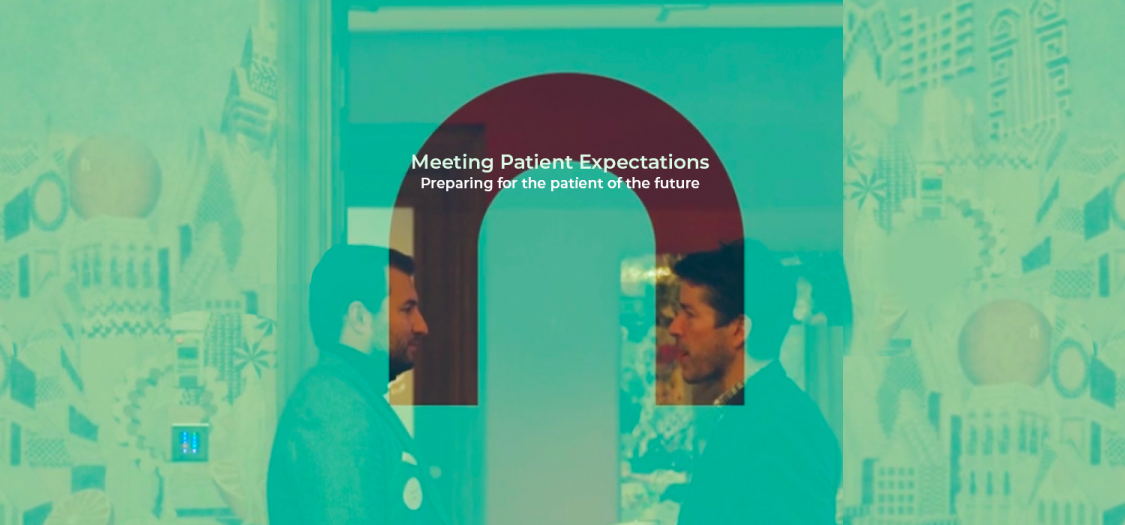

Sunday 18 November 2018,
by Andy Stafford
Patients have always been central to the healthcare story, but not always to the efforts of the various organisations working within the system. Life Science, and Pharma more specifically, for instance, has historically focused its efforts, and budgets, on HCPs. In light of the impact digital has on the way patients find information and make decisions, isn’t it time we make the patient central to the way that we deliver value? Whether it’s via HCPs or directly, patients should be at the heart of everything the healthcare industry does, and one way that pharma can deliver on that in the short to medium term is via their ecosystems.
What do we mean by an ecosystem? It can be defined broadly as a complex network or interconnected system, but Gartner Research defines a digital ecosystem, which we are concerned with here, as:
“...an interdependent group of enterprises, people and/or things that share standardised digital platforms for a mutually beneficial purpose, such as commercial gain, innovation or common interest. Digital ecosystems enable you to interact with customers, partners, adjacent industries ‒ and even your competition.”
A typical example of the more advanced pharma-created digital ecosystems seen in the market today might include: a disease awareness website; an app and/or website for support, incorporating information, stories, medication reminders; and maybe some dedicated medication resources, depending on location and legal approach.
Such approaches still fall well short of an ecosystem that truly serves patient needs or one that is geared towards delivering significant increases in patient outcomes. In fact, our experience suggests that current attempts by pharma can appear rather tokenistic. Driven by risk aversion, pharma ends up producing something for patients that is in no way designed with their true needs at heart.
Debbie Denison, our head of strategy at nitro, and cancer survivor understands both sides of the equation. “Being diagnosed with chronic myeloid leukaemia was one of the scariest times in my life. Thankfully, for my type of cancer, there was targeted therapy, and after my initial round of leukapheresis it was basically, take a pill a day and get lots of blood tests. There was no support at all from the healthcare system or from the drug manufacturer. I had no haematology nurse, my doctor just kept repeating adherence messages, my GP didn’t know how to manage side effects. Frustrated and frightened, I turned to the internet and found an amazing community of people who were going through the same things as me.
Within nitro, I’ve tried to include the patient’s voice in the work we deliver in oncology and haematology, from rewriting safety apps to working with the marketing team on messages for patient sites. Even then, compliance has rejected some of the approaches, which means our project deliverable becomes a watered down version that aligns far more to excessive compliance needs than to the patient needs. We need to do better than that for patients”.
As Debbie highlights above, this is why patients and charities all too often find they have to take action themselves. There are prominent examples among patients, such as Emma Lawton, who has created an online library for Parkinson’s sufferers. This online tool helps to provide patients with the right advice and guides, people to apps, devices and resources that are safe, effective and reasonably priced.
Taking things one step further, a group of Diabetes patients has developed their own diagnostic tools in the absence of healthcare industry solutions. Using the #WEARENOTWAITING hashtag and movement, patients like Andrew Warrington, working with others has created practical solutions for better Diabetes control. Patients, in the absence of solutions for apparent problems, will increasingly either figure out solutions themselves or work with scientists to help them accomplish what they cannot achieve alone.
A recent report by Accenture highlights the perceived lack of patient empowerment which spurs such groups into action; less than half of all patients feel like they have input into which new treatments to select for their conditions, and 63% of [these?] patients want to have such discussions. That same report cited that a quarter of all patients have limited or no knowledge when it comes to understanding new products coming to market that may be suitable for them.
However, while patient needs are still massively underserved online, regardless of whether we look at diagnosis, treatment or support, there appears to be a lack of trust in the pharma industry to bridge this gap. Patients appear not to want (or trust) additional help or support from pharma. This sentiment mirrors the opinions of many HCPs when we ask them if they would like pharma to leverage new channels, contribute or support them more.
This presents a particular challenge for the pharma industry; trust and transparency are fundamental ingredients of a successful ecosystem.
Clearly, patients want to be informed and involved in their treatment decisions, so why the disconnect? These hurdles can be overcome, Eye for Pharma London highlighted some excellent success stories of pharma engaging fully with patients. Having worked collaboratively with pharma, these patient representatives were keen to see more from pharma – in fact, they demanded it.
Aside from the lack of patient trust in the pharma industry, there are other forces at work hampering the development of the formation of interdependent groups highlighted in Gartner Research’s definition. The idea of collaboration with competitors and the constraints of compliance and regulation are all factors to be grappled with in the development of patient-centric digital ecosystems.
Health remains one of the few remaining industries to be really disrupted or even demonstrably changed by digital, but Amazon, Microsoft, Apple, and Google are betting on it, and while they’re sat on a combined wealth of more than half a trillion dollars of cash, who would argue?
Perhaps it is time for pharma to use its considerable expertise, knowledge, and passion for science and health to figure out how it can capitalise on digital technology to solve the actual problems using a data-driven approach; and move beyond the molecule and pill to look at the whole patient.
There are pharma companies already experimenting with data and technology. You can see it in the numerous innovation labs at LEO, Boehringer Ingelheim, Teva, and Pfizer for example, along with the creation of digital-specific teams to, for instance, look at digital biomarkers. Further, the creation of Novartis Biome and high-level acquisitions, such as Roche’s acquisition of Foundation Medicine and Flatiron Health all represents definite, perhaps significant steps in the right direction in so far as accepting that digital represents significant opportunities for business and patient outcomes. A question remains though over how to integrate these initiatives into their existing business models.
Surely an ecosystem fit for the future will include not only a shared vision of the patient outcome, but a shared commitment to make it happen that is cooperative and enables interaction by leveraging technology, behavioural science, and a design thinking approach. Certainly, you can imagine a host of technology such as A.I., V.R. I.o.T. and the like playing a role, but these are all just components of the whole approach.
Doing nothing is not really an option, and who knows, HCPs might be replaced by algorithms in fifteen years time, so it’s time to shift your focus sooner rather than later. Okay, I’m being a little facetious, but with the development of technology like ‘Babylon Health’ maybe I am not?
A patient ecosystem that is fit for the future is not one that is owned by one organisation for their benefit only, it is developed and nurtured by many who share the same vision and commitment. But, the patient ecosystem ideally requires for the lead to be taken by an organisation with a focus on improving the patient experience – not just focusing on the disease- with a commitment on the long-term, whether at a company, franchise or brand/product level.
If you develop a solution that doesn’t work initially, at the very least you will have got there through a commitment to produce solutions focused on problems, and ideally to deliver positive experiences for the patients. In doing so, you will learn a lot about your patients as people, not just their disease, that you can use to improve the next iteration in the shared ecosystem.
Pharma, what is stopping you?
We here at nitro would love to talk to you about ‘delivering better outcomes’, ‘accelerating digital transformation’ and ‘connecting you to your audience faster’. Our view is that there are several steps that pharma should be taking now in its journey to digital patient centricity:
In an increasingly competitive product marketplace, it just makes sense for pharma to work with patients, HCPs and wider stakeholders to help solve problems or seek to improve on the status quo in areas such as education, diet, exercise, and psychology. Anything that helps the patient to improve their knowledge and motivation will inevitably lead to better adherence, right? Okay, this is not a given, and patient support programmes are not easy per se, but then nothing about changing health human behaviour is especially easy.
If your approach is for the benefit of all patients, not just those using the product, focusing on their needs enables you to accomplish much better outcomes whilst simultaneously establishing much deeper levels of trust. An example that comes to mind here is Sanofi Genzyme’s approach within MS. The process of creating services that they needed starts by simply asking them what they needed, and how to accomplish that together.
While pharma is not about to share its clinical research for all to use, more focus should be placed on sharing insights, allowing everyone to contribute to a shared vision that is focused on patient outcomes. Collaborate with healthcare professionals, patients, and other experts on the development of assets and communications and to figure out problems and solutions together.
To give it the buzzword, or technical name, we’re talking about distributed co-creation. LEGO, for instance, invited customers to suggest new models interactively and then financially rewarded the people whose ideas proved marketable.
Using an approach like design thinking and user-centered design can help to design and develop platforms and produce digital assets that are truly going to help improve patient outcomes rather than fulfil a digital box-ticking exercise, so long as the scope of the research and the problem focus is not too narrow. Creating an app on the whim and request of one doctor has a high chance of failure, whereas investigating where the real problems are before designing a solution, on the other hand, has a much greater chance of success.
Collaborate with healthcare professionals, patients, and other experts to figure out problems and solutions. Once underway, accept that digital- just like health- is never done, and should always look to be continually improved based on the data.
Qualitative and quantitative feedback will ensure that the first modest solutions can be expanded and scaled into something genuinely useful to a much wider group of patients with potentially global potential. In other words, they must learn what works and be able to scale.
Similarly to understanding the needs and opportunities of patients, enabling communications with digital HCPs (sometimes called KOIs or DOIs) the needs and opportunities of the healthcare professionals can be better catered for, whether it is in the spread of materials to enhance disease understanding and treatment, or a host of other challenges that they face. How can you work with them to test innovation for them and directly with patients in the healthcare systems?
I’m sure that you will have your own thoughts, challenges and recommendations too. If so, why not come along to our event on the 5th of December when we’ll be tackling this topic in more detail with a mixed panel of patient, pharma, hcp, and technologist. Sign-up here.

